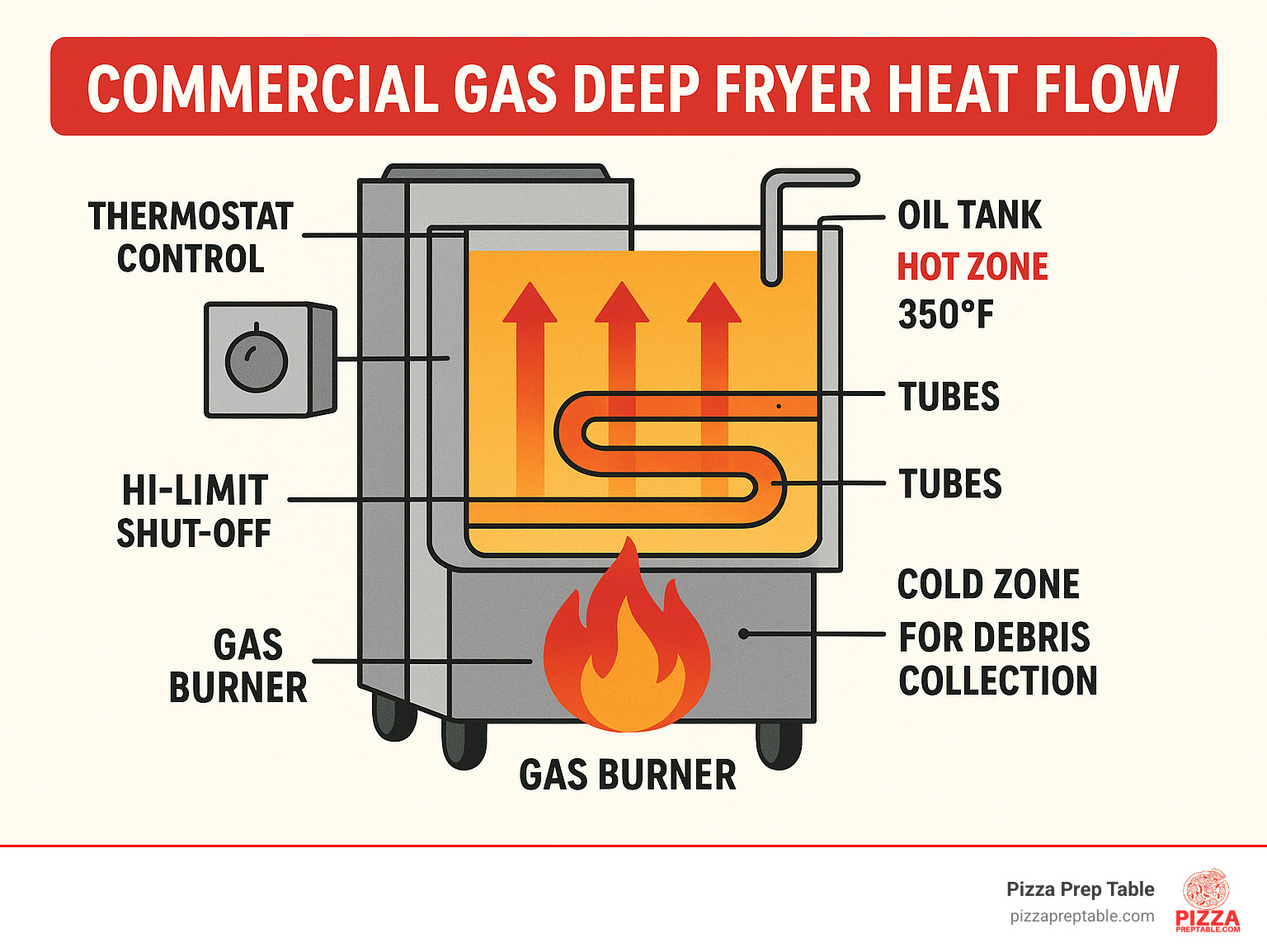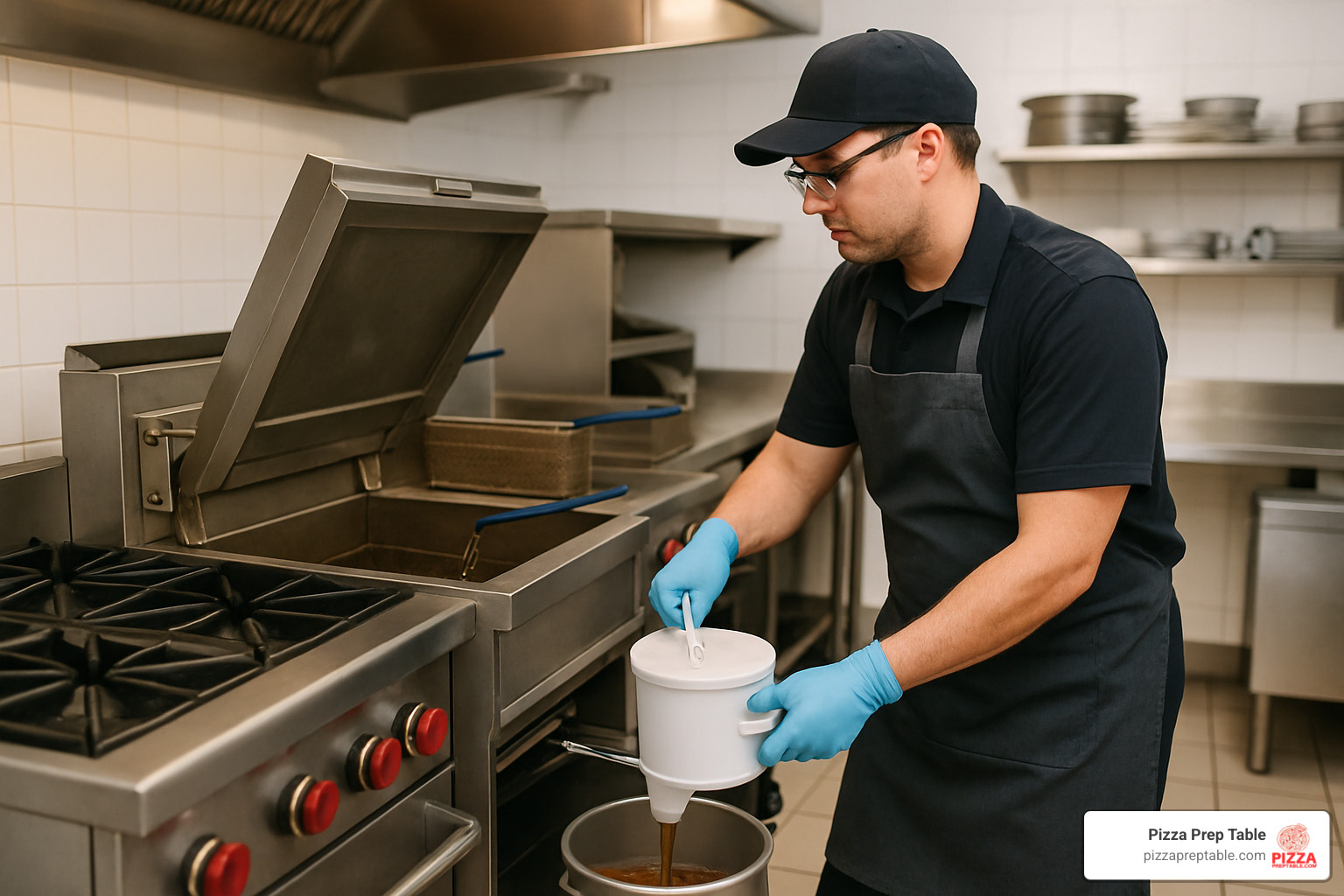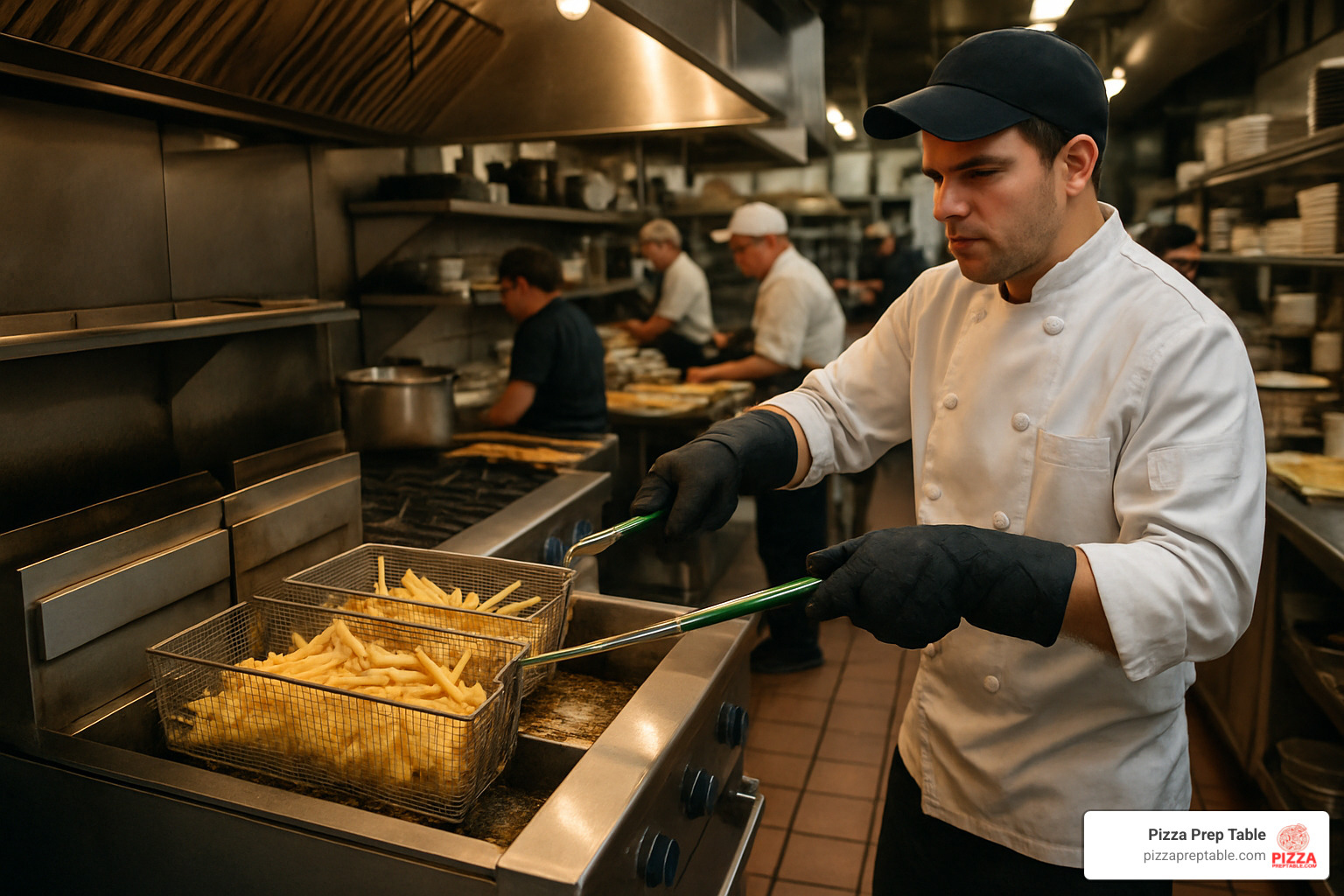
Cook Like a Pro with These Commercial Gas Deep Fryers
Share
Why Commercial Gas Deep Fryers Are Essential for High-Volume Kitchens
A commercial gas deep fryer delivers the power and speed your kitchen needs to keep up with hungry customers. These workhorses can handle everything from crispy fries to golden chicken wings, making them must-have equipment for pizzerias, restaurants, and food trucks.
Top Commercial Gas Deep Fryer Features:
- Oil Capacity: 35-100 lbs per tank for high-volume frying
- BTU Power: Up to 150,000 BTU/hr for fast temperature recovery
- Efficiency: ENERGY STAR models reduce energy consumption by 35%
- Production: Can produce up to 75 lbs of French fries per hour
- Temperature Range: 200°F to 400°F with safety shut-off at 450°F
- Configurations: Floor models and space-saving countertop units
Gas fryers heat up faster than electric models and maintain consistent temperatures even during busy periods. The infrared burners and phased-array heat exchangers found in premium models ensure your oil stays at the perfect frying temperature.
Popular foods for commercial gas deep fryers include:
- French fries and sweet potato strips
- Chicken nuggets, wings, and tenders
- Onion rings and tempura vegetables
- Fish sticks and seafood
- Donuts and specialty desserts
- Mozzarella sticks and jalapeño poppers
I'm Sean Kearney, and my background in sales has taught me how the right restaurant equipment can make or break a food business. Having worked with countless kitchen operators, I understand that choosing the right commercial gas deep fryer is crucial for maximizing both efficiency and profits.

Best Commercial Gas Deep Fryer Picks for 2024

Finding the perfect commercial gas deep fryer for your kitchen doesn't have to be overwhelming. After testing dozens of models and talking with operators across the country, I've narrowed down the standout performers that deliver real value in 2024.
Whether you're running a busy pizzeria or launching a food truck, there's a fryer here that'll match your needs and budget. The best part? Many of these models are available for quick shipping, so you won't be waiting weeks to start cranking out those golden, crispy favorites your customers crave.
The big news this year is how many manufacturers are stepping up with ENERGY STAR certified models. These efficient units can slash your energy bills by up to 35% compared to older fryers. When you're frying all day long, those savings really add up.
High-Volume Floor Models – The Workhorses
When your kitchen is slammed and tickets are flying, you need a commercial gas deep fryer that won't quit on you. The Vulcan LG500 has earned its reputation as a true workhorse, pumping out 150,000 BTU per hour with a massive 70-pound oil capacity. This beast can handle whatever you throw at it, from lunch rushes to dinner crowds.
But here's where things get really interesting. The Ultrafryer IR-RS series takes performance to another level with its clever infrared burner system. Picture this: dual infrared burners working with phased-array heat exchangers to cook food faster while actually using less oil. Your food comes out crispier, and you save money on oil costs.
These floor models aren't just about raw power. They're built smart, with multiple vat configurations that let you fry different foods at different temperatures simultaneously. The built-in filtration systems keep your oil cleaner longer, and that heavy-duty stainless steel construction means they'll be cranking out perfect fries for years to come.
Space-Saving Countertop Champions
Not every kitchen has room for a massive floor unit, and that's perfectly fine. The Trueheat RCF4 proves that good things come in compact packages. With its 18-liter oil capacity and ability to sit flush against non-combustible walls, this little powerhouse maximizes every inch of your kitchen space.
What really impresses me about this Australian-designed fryer is its quick recovery time. You can drop basket after basket, and it bounces back to temperature fast. The open-pot design makes end-of-day cleaning a breeze, while the premium thermostat keeps temperatures rock-steady during your busiest periods.
These countertop champions typically hold 10 to 40 pounds of oil and feature removable tanks that make deep cleaning much easier. They're perfect for smaller operations or as backup units for busy kitchens.
Food-Truck & Pop-Up Favorites
Mobile food operations face unique challenges, and that's exactly what inspired our Crispy Profits Await with These Food Truck Deep Fryers guide. The narrow 15.5-inch wide units with 90,000 BTU output are game-changers for cramped food truck kitchens.
The ZESCO BDGF-90 series exemplifies smart design for mobile operations. Its slim profile doesn't sacrifice power, and the tube-type design with built-in heat deflectors maximizes every BTU. The front drain valve is a godsend when you're working in tight quarters and need to change oil without gymnastics.
These mobile-friendly fryers run on liquid propane, feature adjustable legs for uneven surfaces, and many use millivolt systems that don't need electrical hookups. When every square inch matters, these units deliver big performance in small packages.
Ultra-Efficient & ENERGY STAR Rated Winners
Here's where the magic of modern engineering really shines. ENERGY STAR certified fryers can cut your energy consumption by 35%, and the VEG35M series leads the pack with its dual infrared burners and advanced heat recovery systems.
These efficient models often qualify for substantial utility rebates, making them smart investments that pay for themselves. I've seen operators achieve ROI in under 12 months thanks to the combination of lower operating costs and rebate programs.
The dual infrared technology isn't just about efficiency – it delivers more consistent cooking results. Your food cooks more evenly, and customers notice the difference. Visit Parts Town to order your filters to keep these high-tech systems running at peak performance.
Budget-Friendly Starters Under $2,500
Starting out or working with a tight budget? The Avantco FF400 and MainStreet 40-pound models prove you don't need to spend a fortune to get reliable frying performance. These entry-level units come with 1-year warranties and solid construction that'll serve you well as you grow your business.
The Avantco FF400 particularly impresses with its 50-pound oil capacity and four 30,000 BTU tubes. The cool-zone design traps debris below the heating elements, making cleanup easier and helping your oil last longer. Sometimes the basics done well are exactly what you need to get started.
These budget-friendly options typically hold 40 to 50 pounds of oil, feature standard thermostat controls, and include essential safety features. They're perfect stepping stones that let you start frying without breaking the bank.
How to Choose the Right Commercial Gas Deep Fryer
Choosing the perfect commercial gas deep fryer doesn't have to feel overwhelming. Think of it like finding the right teammate for your kitchen – you need something that matches your pace, handles your volume, and won't let you down during the dinner rush.
The key decision factors boil down to understanding your operation's needs. Oil capacity determines how much food you can fry at once, while BTU rating affects how quickly your fryer bounces back between batches. Recovery time can make or break your ticket times, and good filtration systems will save you serious money on oil costs.
Don't overlook the importance of thermostat type – you'll choose between reliable millivolt systems or precise electronic controls. Make sure any fryer you consider has NSF and ETL certifications for safety and health department compliance.
Here's how gas and electric fryers stack up in real-world performance:
| Feature | Gas Fryers | Electric Fryers |
|---|---|---|
| Heat-up Time | 8-12 minutes | 15-20 minutes |
| Recovery Speed | Excellent | Good |
| Operating Cost | Lower (typically) | Higher |
| Installation | Gas line required | High-voltage electrical |
| Temperature Control | Responsive | Very precise |
| Maintenance | Moderate | Lower |
Gas fryers clearly win on speed and operating costs, which is why most high-volume kitchens prefer them.
Matching Fryer Size to Menu & Volume
Your menu tells the story of what size commercial gas deep fryer you need. A standard 40 lb capacity fryer can pump out about 75 pounds of French fries per hour – perfect for most pizza shops and casual dining spots.
But if you're planning to serve bone-in chicken or other proteins that need longer cook times, you'll want larger vats with deeper cold zones. That cold-zone depth isn't just a fancy feature – it keeps food particles away from heating elements, which means cleaner oil and better-tasting food.
Think about your peak hours when sizing your fryer. Small operations like food trucks and cafes typically do well with 35-40 lb capacity units. Medium restaurants usually need 50-70 lb capacity to handle busy periods without bottlenecks. High-volume kitchens often require 85-100 lb capacity or multiple smaller units.
Multi-vat systems make sense when you're frying different foods that need different oil temperatures – like keeping one vat for fries and another for chicken.
Key Features Checklist
Shopping for a commercial gas deep fryer means looking beyond the shiny exterior. The most important safety feature is hi-limit shut-off protection that kicks in around 450°F to prevent dangerous overheating. Flame-failure safety devices automatically shut off gas flow if the pilot light goes out.
Built-in filtration systems can extend your oil life significantly – some operators report cutting oil costs in half. Programmable controls help maintain consistency, especially when you have multiple cooks working different shifts.
Look for cold-zone design that traps debris below the heating elements. This simple feature makes cleaning easier and keeps your oil fresher longer. Full-port drain valves speed up oil changes, and splash guards protect your staff from hot oil splatters.
Construction quality matters for longevity. Stainless steel tanks resist corrosion and clean easily. Adjustable legs help you get proper installation on uneven floors. Nickel-plated racks and baskets last longer than basic steel versions.
More info about oil storage can help you plan your complete frying operation and maximize your investment.
Installation & Utility Requirements
Getting your commercial gas deep fryer installed properly is crucial for both safety and performance. Most units need a 3/4" gas line, though high-BTU models might require 1-1/4" lines to deliver adequate gas flow. You'll also need a 48" flexible gas hose with proper restraining cables.
Ventilation requirements vary by local codes, but plan on installing commercial hoods with adequate CFM ratings. Your local health department and building inspector will have specific requirements for your area. Floor clearances typically need 6 inches on all sides for proper airflow and cleaning access.
Here's some good news – many ENERGY STAR certified fryers qualify for utility rebates that can offset installation costs. These rebates are especially generous in energy-conscious markets like California, sometimes covering hundreds of dollars in equipment costs.
Maintenance, Oil Management & Safety Essentials

Taking care of your commercial gas deep fryer isn't just about keeping it clean - it's about protecting your investment and your customers. Think of it this way: a well-maintained fryer is like a reliable car that gets you where you need to go without breaking down during rush hour.
The good news? Most maintenance tasks are straightforward once you get into a routine. Daily cleaning, proper oil management, and understanding your safety systems will keep your fryer running smoothly for years. Plus, proper oil filtration can extend oil life by up to 50%, which means real money back in your pocket.
Regular boil-out cycles and attention to your cold-zone areas prevent the buildup that can turn a great fryer into a headache. Your customers will taste the difference, and your bottom line will thank you.
Extending Oil Life & Flavor
Here's where smart operators separate themselves from the pack. Oil filtration systems can save up to 50% on oil costs, and that's not just marketing talk - it's real savings you'll see every month. Triple filtration kits take this even further, giving you restaurant-quality results that keep customers coming back.
The secret weapon in modern fryers is the cold-zone design. This clever feature traps food particles and debris below the heating elements, preventing them from burning and contaminating your oil. It's like having a built-in safety net that doubles your oil life in busy kitchens.
Sediment pans collect the debris that naturally falls during frying, making cleanup easier and protecting your oil quality. Clean these daily during high-volume periods, and you'll notice the difference in both oil life and food taste.
Temperature management matters just as much as filtration. Overheating oil breaks it down faster and creates off-flavors that customers will definitely notice. Keep your fryer at proper temperatures, filter oil daily during busy periods, and use test strips to monitor quality.
Scientific research on oil life shows how proper management affects both food quality and health considerations.
Daily & Weekly Cleaning Routine
The drain valve is your best friend when it comes to daily maintenance. Full-port drain valves make oil removal faster and cleaner, reducing the mess and labor time that nobody enjoys. Use the valve properly, and you'll avoid those frustrating spills that seem to happen at the worst possible times.
Boil-out cycles are your weekly deep-clean powerhouse. Most commercial units come with a 5-foot boil-out hose that makes this process manageable. The stainless screens in your filtration system need regular attention too - dirty screens defeat the purpose of having filtration in the first place.
Your daily routine should focus on filtering and testing oil quality, cleaning fryer baskets and racks, wiping down surfaces, and checking those cold-zone areas. Weekly tasks go deeper: complete boil-out cleaning cycles, deep cleaning the filtration system, inspecting gas connections, and sanitizing all removable components.
NSF compliance isn't just about passing inspections - it's about maintaining the standards that keep your customers safe and your reputation intact. Clean equipment works better, lasts longer, and produces better-tasting food.
Critical Safety Features & Best Practices
Modern commercial gas deep fryers come loaded with safety features that work behind the scenes to protect you and your staff. Auto shut-off systems kick in at 450°F to prevent dangerous overheating, while flame-failure devices immediately shut off gas flow if the pilot light goes out.
Hi-limit resets are another crucial safety feature that every operator should understand. When your fryer's safety system trips, there's usually a good reason - don't just reset it without figuring out what caused the problem in the first place.
Fire suppression systems like Ansul units are often required by local codes, especially in high-volume operations. Employee training on proper PPE (personal protective equipment) is just as important as having the right safety equipment. Heat-resistant gloves and aprons aren't suggestions - they're necessities in a busy kitchen.
Emergency procedures should be second nature to your staff. Everyone should know where the gas shut-off is located, how to use fire suppression equipment, and what to do if someone gets burned. First aid supplies specifically for burn treatment should be easily accessible.
Propane Power: Commercial Deep Fryers That Bring the Heat provides additional safety information for propane-powered units, including specific considerations for mobile operations.
Boosting Kitchen Productivity & Profits with a Commercial Gas Deep Fryer

A commercial gas deep fryer is more than a cooking tool—it’s a profit engine. Phased-array heat exchangers and infrared burners keep oil at the ideal temperature so orders fly out fast and consistently.
Faster Ticket Times, Happier Guests
Top fryers bounce back to set temperature in under two minutes, eliminating downtime. Multi-vat designs let you cook chicken tenders, onion rings, and signature fries simultaneously with no flavor crossover. One vat can produce 75 lbs of fries per hour, and multiplying vats means serious throughput that keeps guests smiling.
Lower Operating Costs = Higher Margins
ENERGY STAR models cut energy use by up to 35 % and often qualify for rebates that slash payback periods to months, not years. Built-in filtration and cold-zone designs can halve your oil spend, while predictive-maintenance alerts let you schedule service before breakdowns interrupt revenue.
Scaling Up: When to Add a Second Fryer
If wait times creep up during peaks or new menu ideas are on hold, it’s time for another fryer. Modular batteries with joiner strips double capacity without doubling labor, opening doors to lucrative catering orders and large take-out runs.
Frequently Asked Questions about Commercial Gas Deep Fryers
What foods can I cook besides fries?
Your commercial gas deep fryer opens up a world of menu possibilities that goes way beyond french fries. I've seen pizzeria owners transform their operations by adding crispy chicken wings and mozzarella sticks to complement their pizza offerings.
Protein options work beautifully in commercial fryers - think chicken nuggets, tenders, and wings that cook evenly thanks to consistent oil temperatures. Seafood lovers will appreciate perfectly golden fish sticks, crispy shrimp, and beer-battered cod. The high BTU output of gas fryers handles the temperature drop when you add cold proteins.
Vegetable dishes are equally impressive. Tempura vegetables, onion rings, and fried zucchini sticks cook quickly and stay crispy. Many operators dedicate one vat to vegetables to accommodate customers with dietary restrictions.
Don't overlook specialty items that can boost your profit margins. Fried tortilla bowls for salads, jalapeño poppers, and even donuts for dessert menus all work great. The key is managing your oil temperatures and using separate baskets to prevent flavor transfer between different food types.
How often should I filter or change the oil?
Oil management makes the difference between profitable frying and throwing money down the drain. High-volume kitchens should filter oil daily during busy periods, while smaller operations can often get away with filtering every 2-3 days.
The type of food you're frying matters more than you might think. Heavy breading and batter breaks down oil faster and requires more frequent filtration. If you're doing a lot of chicken or fish, plan on more maintenance. Simple items like french fries are much easier on your oil quality.
Complete oil changes typically happen weekly or bi-weekly, but don't guess - use oil test strips to know for sure. These inexpensive strips take the guesswork out of oil management and can save you hundreds of dollars monthly by preventing premature oil disposal.
Here's what I tell my customers: good filtration can extend oil life by 50%, and that savings adds up fast in a busy kitchen. The built-in filtration systems on quality commercial gas deep fryers pay for themselves quickly through reduced oil costs.
Do I need a hood for a countertop commercial gas deep fryer?
Yes, you'll need a commercial hood system for virtually any commercial gas deep fryer, even compact countertop models. This isn't just a suggestion - most health departments and fire codes require proper ventilation for any commercial frying equipment.
The hood system must provide adequate CFM (cubic feet per minute) of exhaust to handle the heat and grease vapors that commercial frying produces. Even those neat little countertop units that seem so convenient still generate significant heat and vapors that need proper exhaust.
Food truck operators face the same requirements, though mobile ventilation systems can be more compact. I've worked with food truck owners who thought they could skip the hood with a small fryer, only to fail their health inspection.
Local codes vary significantly, so check with your health department and fire marshal before making any equipment decisions. Some jurisdictions have specific requirements for gas appliances that differ from electric units. Getting this right from the start saves you from costly modifications later.
The good news is that proper ventilation makes your kitchen more comfortable for staff and creates a better dining environment for customers. Nobody wants to eat in a place that smells like old fryer oil.
Conclusion
Choosing the perfect commercial gas deep fryer doesn’t have to be complicated. Whether you need a high-capacity floor unit for a Friday-night rush or a compact countertop model for a food truck, the right fryer is out there.
At PizzaPrepTable.com we make upgrading easy with flexible financing, so cash flow never stands between you and the equipment your kitchen deserves. Operators from New York pizzerias to California beach-side trucks have boosted speed, consistency, and profits by partnering with us.
Between ENERGY STAR savings, longer oil life, and faster ticket times, many customers see full payback in under a year. Ready to level up? Explore our complete selection of commercial gas deep fryers today—our specialists are standing by to help.
For mobile kitchens, see Rolling Kitchens 101: What Equipment Does a Food Truck Need? for additional insights.
